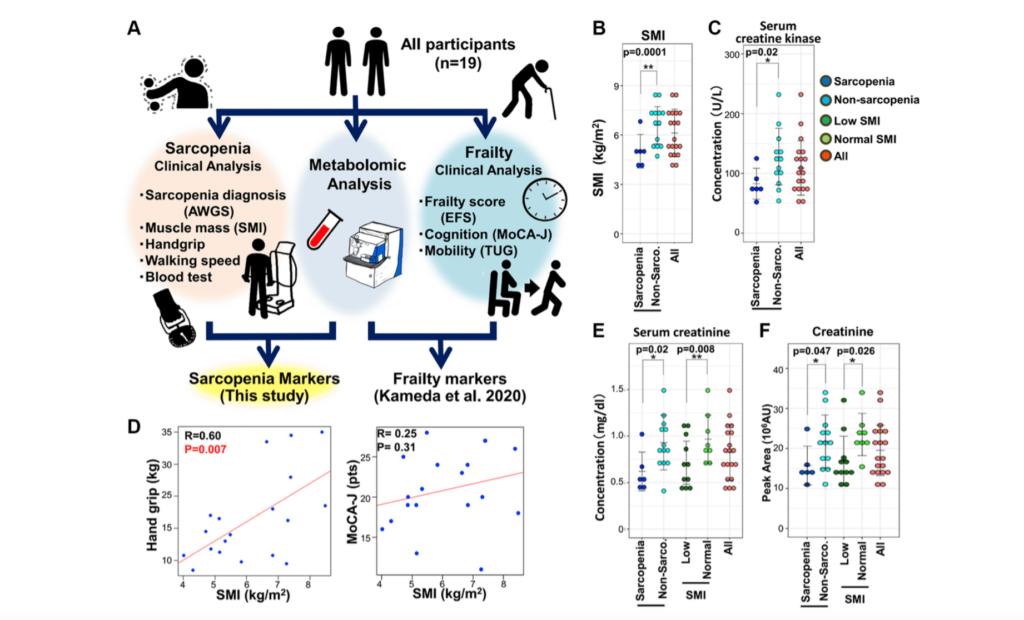The Trending with Impact series highlights Aging (Aging-US) publications that attract higher visibility among readers around the world online, in the news, and on social media—beyond normal readership levels. Look for future science news about the latest trending publications here, and at Aging-US.com.
—
Sarcopenia is a common clinical condition that befalls the elderly—defined as a loss of skeletal muscle and muscle strength. Sarcopenic patients share clinical features with physical frailty. Physical frailty is a subtype of the condition of frailty—a broadly defined condition that typically encompasses multiple domains of aging, including cognitive impairment and decreased mobility and social activity. Sarcopenia and frailty are both deeply affected by aging, however, the underlying metabolic bases they stem from have remained unclear. How molecularly similar are sarcopenia and frailty? Are they spawned from the same cause?
“[…] little is known about the metabolic basis of sarcopenia, either shared with or discrete from frailty.”
In 2021, researchers from Kyoto University and Okinawa Institute of Science and Technology Graduate University collected blood samples from a cohort of elderly participants (from a previous study on frailty), and analyzed the samples in relation to sarcopenia. Their research paper was published as the cover of Aging (Aging-US) Volume 13, Issue 17, and entitled, “Reduced uremic metabolites are prominent feature of sarcopenia, distinct from antioxidative markers for frailty.”
The Study
To assess the metabolic profiles of both sarcopenia and frailty, the researchers used a new branch of chemistry, metabolomics, to quantitatively analyze whole blood samples (taken from their previous frailty study) from 19 elderly patients. The team analyzed the metabolomic data from the elderly group in the context of sarcopenia diagnoses.
“Metabolomics is a newly developed branch of chemistry that detects and quantifies small molecules, called metabolites, using methods such as liquid chromatography- mass spectrometry (LC-MS) [18].”

In the frailty study, the researchers had previously found 15 frailty markers, including antioxidants. In the current study of sarcopenia, they identified 25 sarcopenia-related metabolites (22 sarcopenia markers and 10 overlapping skeletal muscle index (SMI) markers). The 25 sarcopenia markers were related to mitochondria, kidney function, nitrogen metabolism, and methylated compounds.
“Interestingly, most metabolites that decreased in sarcopenia or low SMI are uremic compounds that increase as a result of kidney impairment. Thus, metabolite profiles in sarcopenia are largely distinct from those of frailty.”
Conclusion
The researchers note that despite the clinical and metabolomic information being extracted from the same datasets, 22 of the sarcopenia markers were distinct from the 15 previously reported frailty markers (including from antioxidants). This metabolomic analysis reveals a new metabolite profile of sarcopenia that was previously unknown, and that sarcopenia is distinct from frailty.
“These metabolites could be developed into the future clinical use, as some metabolites, such as leucine and isoleucine, were effective to improve muscle quality [40].”
Click here to read the full research paper, published by Aging.
WATCH: AGING VIDEOS ON LABTUBE
—
Aging is an open-access journal that publishes research papers monthly in all fields of aging research and other topics. These papers are available to read at no cost to readers on Aging-us.com. Open-access journals offer information that has the potential to benefit our societies from the inside out and may be shared with friends, neighbors, colleagues, and other researchers, far and wide.
For media inquiries, please contact [email protected].

